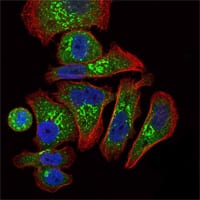
| WB | 1/500 - 1/2000 | Human,Mouse,Rat |
| IF | 咨询技术 | Human,Mouse,Rat |
| IHC | 咨询技术 | Human,Mouse,Rat |
| ICC | 1/200 - 1/1000 | Human,Mouse,Rat |
| FCM | 咨询技术 | Human,Mouse,Rat |
| Elisa | 1/10000 | Human,Mouse,Rat |
| Aliases | EP; MVCD2; MGC138142; EPO |
| Entrez GeneID | 2056 |
| clone | 4F11 |
| WB Predicted band size | 21kDa |
| Host/Isotype | Mouse IgG1 |
| Antibody Type | Primary antibody |
| Storage | Store at 4°C short term. Aliquot and store at -20°C long term. Avoid freeze/thaw cycles. |
| Species Reactivity | Human |
| Immunogen | Purified recombinant fragment of human EPO expressed in E. Coli. |
| Formulation | Purified antibody in PBS with 0.05% sodium azide. |
+ +
以下是关于EPO抗体的模拟参考文献示例(仅供参考,非真实文献):
---
1. **文献名称**:*Development of High-Specificity Monoclonal Antibodies Against Human Erythropoietin for Clinical Diagnostics*
**作者**:A. Müller et al.
**摘要**:研究团队开发了一种针对人EPO的高特异性单克隆抗体,用于区分内源性和外源性EPO。该抗体在ELISA和Western Blot中表现出高灵敏度,适用于兴奋剂检测和贫血相关疾病的诊断。
2. **文献名称**:*Autoantibodies to Erythropoietin in Patients with Pure Red Cell Aplasia: Mechanisms and Therapeutic Implications*
**作者**:K. Tanaka et al.
**摘要**:探讨纯红细胞再生障碍性贫血(PRCA)患者体内EPO自身抗体的产生机制,发现其通过中和EPO活性导致贫血恶化,为免疫抑制疗法提供了理论依据。
3. **文献名称**:*A Novel Multiplex Immunoassay for Simultaneous Detection of EPO and Its Neutralizing Antibodies*
**作者**:R. Gupta et al.
**摘要**:提出一种新型多重免疫检测方法,可同步量化血清中EPO浓度及其中和抗体水平,显著提高了慢性肾病患者治疗监测的效率。
4. **文献名称**:*Epitope Mapping of Anti-EPO Antibodies Using Phage Display Technology*
**作者**:S. Park et al.
**摘要**:利用噬菌体展示技术解析了EPO单克隆抗体的结合表位,揭示了其与EPO受体竞争性结合的分子机制,为开发治疗性抗体奠定基础。
---
**备注**:以上为模拟文献,如需真实文献建议通过PubMed或Google Scholar检索关键词(如"EPO antibody"、"anti-EPO monoclonal"、"EPO autoantibodies"),并筛选近年高影响力期刊(如*Blood*、*Analytical Chemistry*、*Kidney International*)。
×